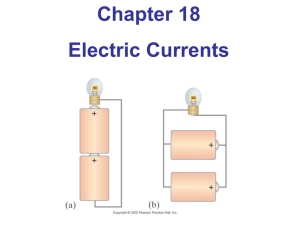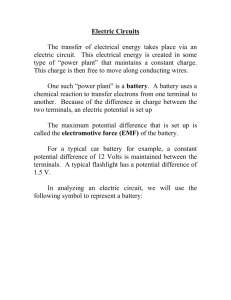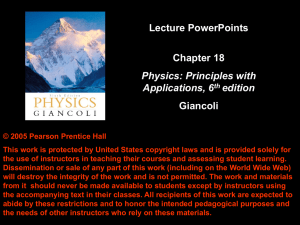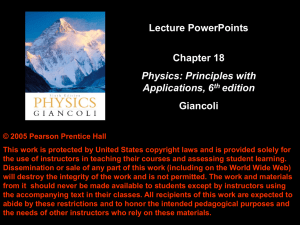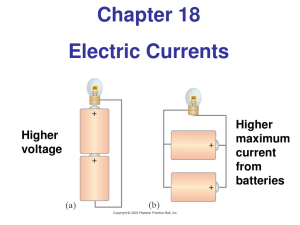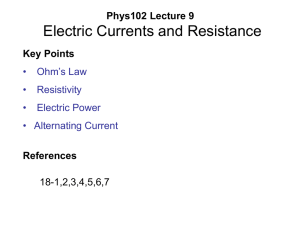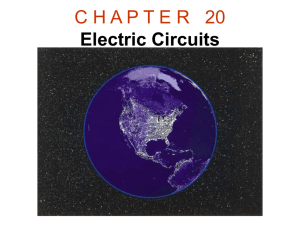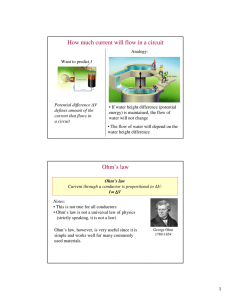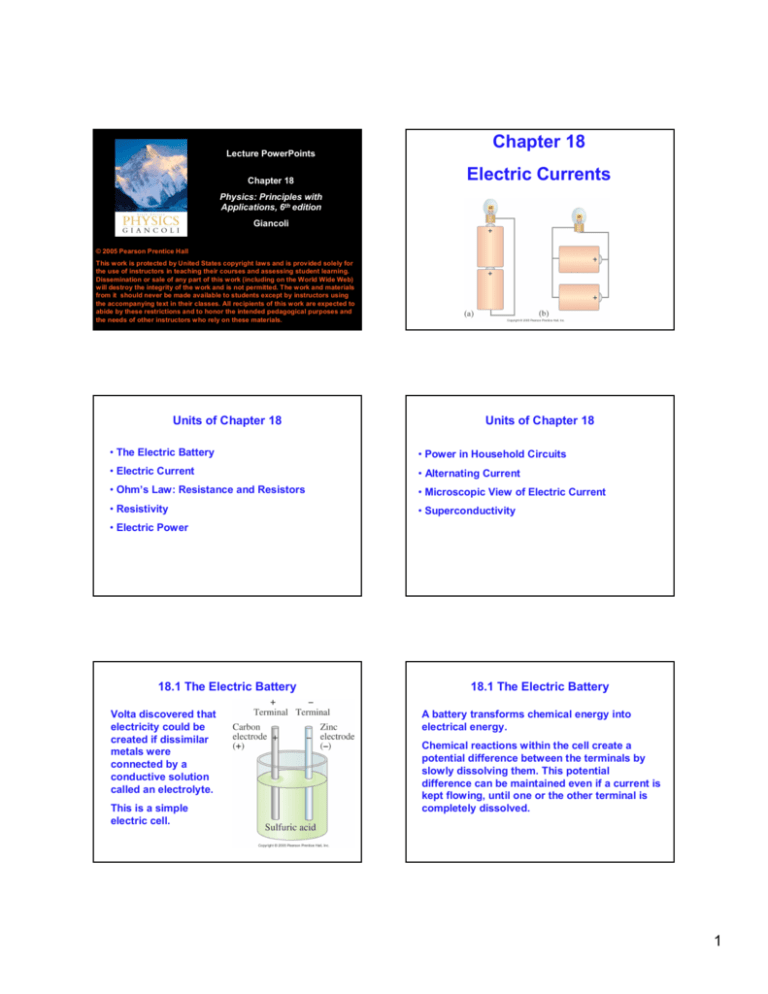
Lecture PowerPoints
Chapter 18
Chapter 18
Electric Currents
Physics: Principles with
Applications, 6th edition
Giancoli
© 2005 Pearson Prentice Hall
This work is protected by United States copyright laws and is provided solely for
the use of instructors in teaching their courses and assessing student learning.
Dissemination or sale of any part of this work (including on the World Wide Web)
will destroy the integrity of the work and is not permitted. The work and materials
from it should never be made available to students except by instructors using
the accompanying text in their classes. All recipients of this work are expected to
abide by these restrictions and to honor the intended pedagogical purposes and
the needs of other instructors who rely on these materials.
Units of Chapter 18
Units of Chapter 18
• The Electric Battery
• Power in Household Circuits
• Electric Current
• Alternating Current
• Ohm’s Law: Resistance and Resistors
• Microscopic View of Electric Current
• Resistivity
• Superconductivity
• Electric Power
18.1 The Electric Battery
Volta discovered that
electricity could be
created if dissimilar
metals were
connected by a
conductive solution
called an electrolyte.
This is a simple
electric cell.
18.1 The Electric Battery
A battery transforms chemical energy into
electrical energy.
Chemical reactions within the cell create a
potential difference between the terminals by
slowly dissolving them. This potential
difference can be maintained even if a current is
kept flowing, until one or the other terminal is
completely dissolved.
1
18.1 The Electric Battery
Several cells connected together make a
battery, although now we refer to a single
cell as a battery as well.
18.2 Electric Current
Electric current is the rate of flow of charge
through a conductor:
(18-1)
Unit of electric current: the ampere, A.
1 A = 1 C/s.
18.2 Electric Current
A complete circuit is one where current can
flow all the way around. Note that the
schematic drawing doesn’t look much like the
physical circuit!
18.2 Electric Current
By convention, current is defined as flowing
from + to -. Electrons actually flow in the
opposite direction, but not all currents consist
of electrons.
18.2 Electric Current
In order for current to flow, there must be a
path from one battery terminal, through the
circuit, and back to the other battery
terminal. Only one of these circuits will work:
18.8 Microscopic View of Electric Current
Electrons in a conductor have large, random
speeds just due to their temperature. When a
potential difference is applied, the electrons
also acquire an average drift velocity, which is
generally considerably smaller than the
thermal velocity.
2
18.8 Microscopic View of Electric Current
18.3 Ohm’s Law: Resistance and
Resistors
This drift speed is related to the current in the
wire, and also to the number of electrons per unit
volume, n.
Experimentally, it is found that the current in
a wire is proportional to the potential
difference between its ends:
(18-10)
18.3 Ohm’s Law: Resistance and
Resistors
The ratio of voltage to current is called the
resistance:
(18-2a)
(18-2b)
18.3 Ohm’s Law: Resistance and
Resistors
In many conductors, the
resistance is independent
of the voltage; this
relationship is called
Ohm’s law. Materials that
do not follow Ohm’s law
are called nonohmic.
Unit of resistance: the ohm,
1
18.3 Ohm’s Law: Resistance and
Resistors
Some clarifications:
• Batteries maintain a (nearly) constant
potential difference; the current varies.
.
= 1 V/A.
18.4 Resistivity
The resistance of a wire is directly
proportional to its length and inversely
proportional to its cross-sectional area:
• Resistance is a property of a material or
device.
• Current is not a vector but it does have a
direction.
(18-3)
The constant , the resistivity, is
characteristic of the material.
• Current and charge do not get used up.
Whatever charge goes in one end of a circuit
comes out the other end.
3
18.4 Resistivity
18.4 Resistivity
For any given material, the resistivity
increases with temperature:
(18-4)
Semiconductors are complex materials, and
may have resistivities that decrease with
temperature.
18.9 Superconductivity
In general, resistivity decreases as temperature
decreases. Some materials, however, have
resistivity that falls abruptly to zero at a very low
temperature, called the critical temperature, TC.
18.9 Superconductivity
Experiments have shown that currents, once
started, can flow through these materials for
years without decreasing even without a
potential difference.
Critical temperatures are low; for many years no
material was found to be superconducting above
23 K.
More recently, novel materials have been found
to be superconducting below 90 K, and work on
higher temperature superconductors is
continuing.
18.5 Electric Power
18.5 Electric Power
Power, as in kinematics, is the energy
transformed by a device per unit time:
The unit of power is the watt, W.
For ohmic devices, we can make the
substitutions:
(18-6a)
(18-5)
(18-6b)
4
18.3 Ohm’s Law: Flashlights
Buy good speaker cables!
Speakers have low resistance!
What is the resistance of the bulb?
V = 1.5 Volt
Typically R = 4 Ω
P = 0.15 Watt
I = P/V = 0.1 A
R = V/I = 15 Ω
Total resistance of cable?
Cheap junk: A = 1 mm2
What is the power if V = 1.2 Volt?
P = V2/R = 0.096 Watt
R = ρ L/A = 0.34 Ω
per wire to and from!
Where does the energy go?
We have energy conservation, so electric power
corresponds to energy turned into another form,
usually heat.
18.5 Electric Power
What you pay for on your electric bill is not
power, but energy – the power consumption
multiplied by the time.
We have been measuring energy in joules, but
the electric company measures it in kilowatthours, kWh.
Standard (incandescent) lightbulbs turn only a
few per cent of the energy into light, the rest
ends up as heat.
A 100-Watt bulb costs 6$ per month of operation.
18.6 Power in Household Circuits
The wires used in homes to carry electricity
have very low resistance. However, if the
current is high enough, the power will increase
and the wires can become hot enough to start a
fire.
18.6 Power in Household Circuits
Fuses are one-use items – if they blow, the
fuse is destroyed and must be replaced.
To avoid this, we use fuses or circuit breakers,
which disconnect when the current goes above
a predetermined value.
5
18.6 Power in Household Circuits
Circuit breakers, which are now much more
common in homes than they once were, are
switches that will open if the current is too
high; they can then be reset.
18.6 Power in Household Circuits
Will the fuse blow?
Total power P = 3,450 W
Total current
I = P/V = 28.75 A
It should blow ….
18.7 Alternating Current
18.7 Alternating Current
The voltage varies sinusoidally with time:
Current from a battery
flows steadily in one
direction (direct current,
DC). Current from a
power plant varies
sinusoidally (alternating
current, AC).
18.7 Alternating Current
Multiplying the current and the voltage gives
the power:
as does the current:
(18-7)
18.7 Alternating Current
Usually we are interested in the average power:
6
Summary of Chapter 18
18.7 Alternating Current
The current and voltage both have average
values of zero, so we square them, take the
average, then take the square root, yielding the
root mean square (rms) value.
(18-8a)
• A battery is a source of constant potential
difference.
• Electric current is the rate of flow of electric
charge.
• Conventional current is in the direction that
positive charge would flow.
• Resistance is the ratio of voltage to current:
(18-8b)
Summary of Chapter 18
• Ohmic materials have constant resistance,
independent of voltage.
• Resistance is determined by shape and
material:
Summary of Chapter 18
• Power in an electric circuit:
• Direct current is constant
• Alternating current varies sinusoidally
•
is the resistivity.
Summary of Chapter 18
Summary of Chapter 18
• The average (rms) current and voltage:
• Relation between drift speed and current:
7


